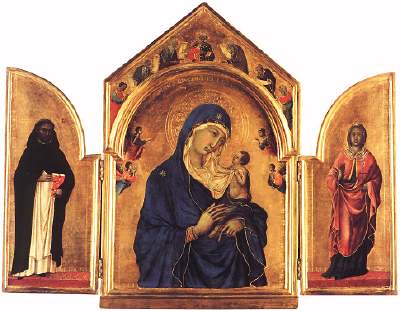雜七雜八
希望有人喜歡:)
The Gothic and Medieval Age 1300-1500
Madonna and Child, (triptych detail) c. 1315
National Gallery, London
Western art begins with Duccio di Buoninsegna, who learned his craft from studying the illuminated manuscripts created by unknown Byzantine limners. His earlier recorded work, dating about 1278, was to decorate the cases in which the municipal records of Sienna were stored. In 1285 he was commissioned to paint a large Madonna for the church of Santa Maria Novella. This is now known as the Rucellai Madonna, for centuries attributed to Cimabue. Duccio painted the magnificent double altarpiece for the Cathedral of Siena, regarded as his masterpiece and one of the greatest painting of all time. Many other works documented in the Sienese records have been lost, but sufficient remain to establish Duccio s the last and greatest of the artist working in the Byzantine tradition, as well as the founder of the Sienese School, and thus the progenitor of modern art. In his hands the degenerate painting of the Gothic style was transformed and the principles of expressive portraiture established.
Duccio, who worked in Siena in the early 14 century. His great achievement was to combine a more flexible style and wider emotional range with the Byzantine tradition. His figures are subtly shaded but lack the solidity of Giotto’s. The crimson, blue and black colour combinations are typical of Duccio.
Duccio di Buoninsegna: Born c. 1255 Siena, Italy. Died 1319.




